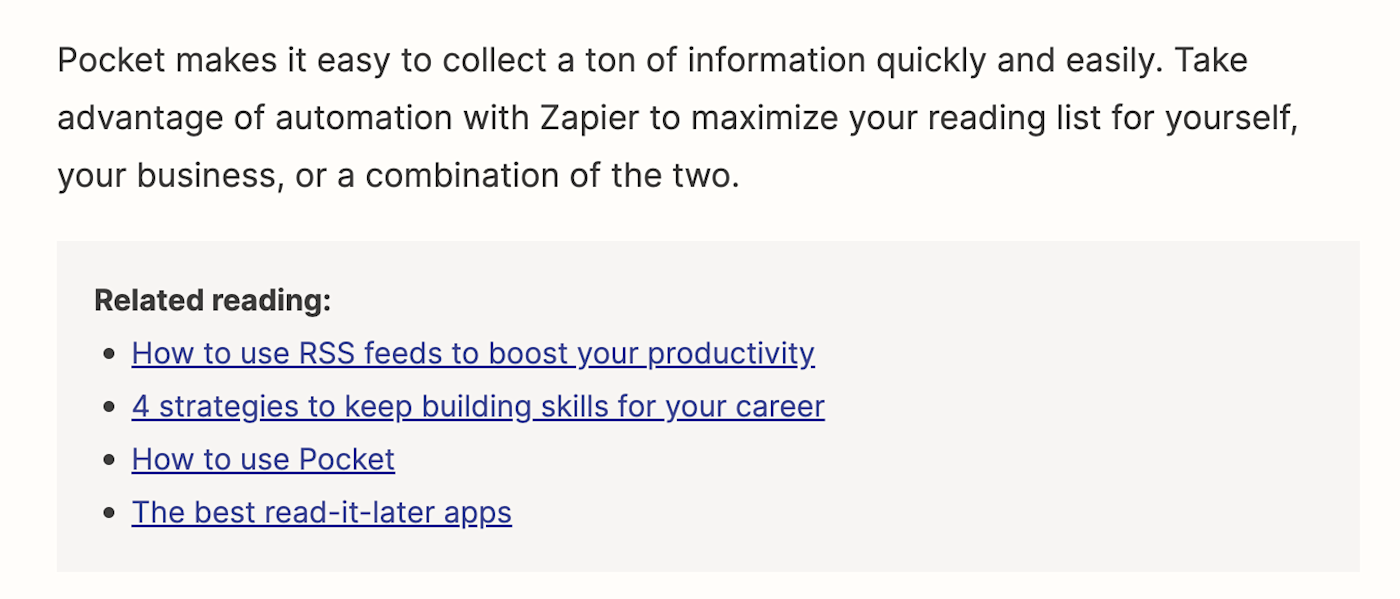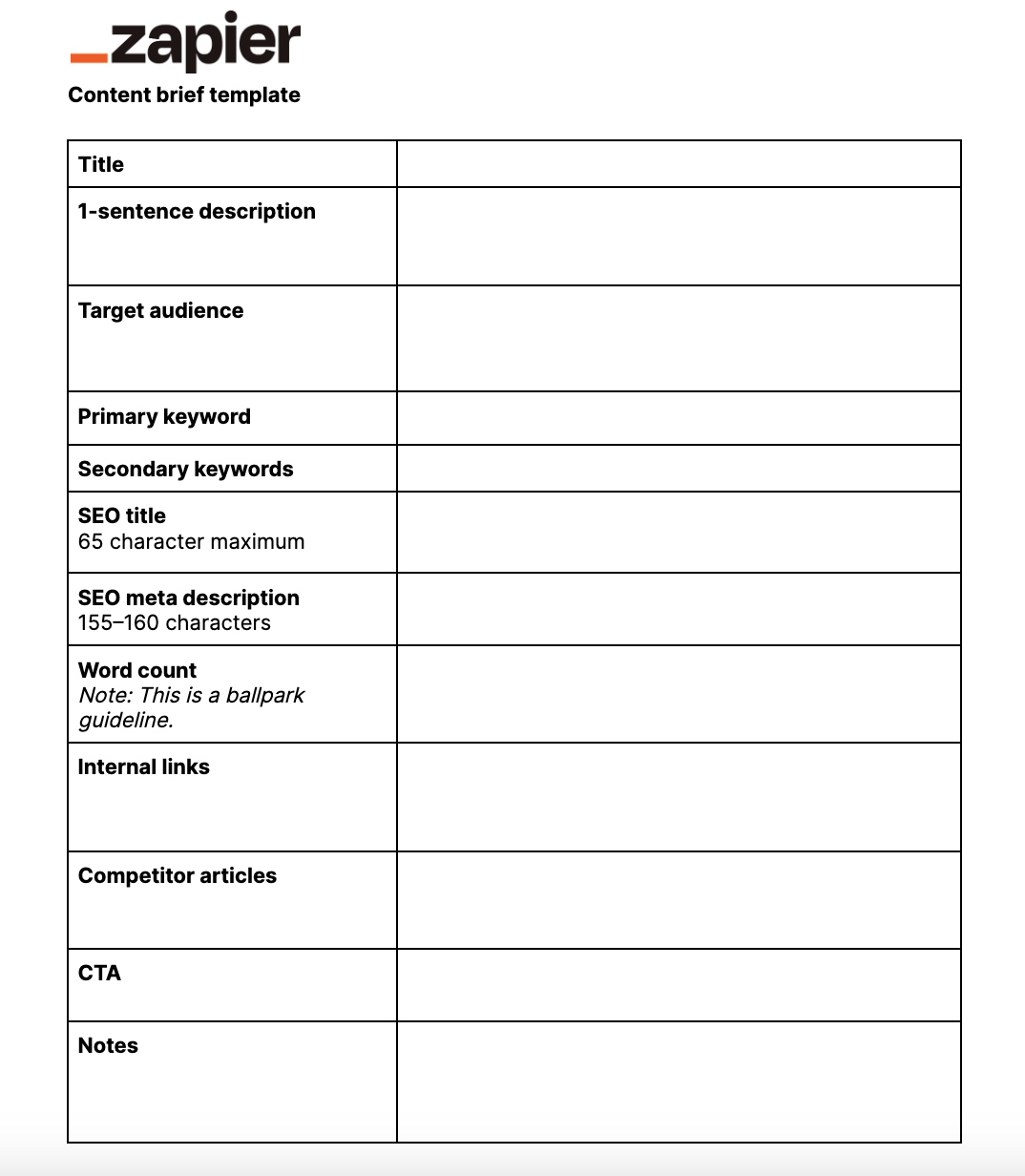Writing a blog post shouldn't be a matter of filling out a template—that's a recipe for disappearing into the internet content landfill. But using a template for a blog post brief is a great way to make sure your writers have all the information they need before diving in.
Here's a link to our content brief template in Google Docs. Make a copy and give it a spin, but first, keep reading for insights on how to make the most of it.
If you use an app to manage your editorial calendar, you can automate the process of creating the brief. Include fields in your app for each of the template sections, and then automatically populate the template every time you mark the article as "In progress."
What is a content brief—and when should you use one?
A content brief is a short (brief!) document that offers a high-level overview of what a piece of content will include. When using it for blog content, it usually includes notes on everything from keywords and internal links to audience and competitor articles.
Full disclosure: we don't really use article briefs at Zapier. But there's a reason for that: we've had more than a decade to figure out what we're doing, and we've found a groove that works without them. Having said that, there are definitely exceptions—times when we recommend using briefs, even for content types you've done a million times.
Here are a few situations where using a brief is important:
When you're creating a very standardized content type. An example would be our best apps pieces—they have the same structure every time, so we have a brief template for them.
When you're working with inexperienced writers. Experienced marketers think about their audience and can generally put together an outline without a template. But if you're working with less experienced writers, it can help them keep their audience, keywords, and goals in mind.
If a partner is writing the article. If you're working with a partner, it's likely they have their own blog with their own standards, voice, and style. A brief can help you be sure they give you what you're looking for instead of defaulting to their own rules.
When you're working with agencies. Agencies might be working with hundreds or even thousands of clients, which means you need to be more in-your-face about your company's needs. (Note: if you're working with an agency or freelancer, you might want to add a Tone and style section to your brief so that brand voice is fresh in their mind.)
SEO content brief template
Here's our content brief example to kickstart your process. Make a copy, and then personalize it for your brand.
How to write a content brief
There are two ways to fill out an article brief template: you can do it, or you can have your writers do it. Which you choose depends on a lot of factors, but here, I'm assuming you'll be filling this out for your writers.
Title
Drop the suggested title of the article here. The title might—and probably will—change after the writer has completed the draft, but this will ensure everyone's in alignment on the hook for the article: what is it that's going to make people want to read this post?
1-sentence description
Other than the target audience, I'd say this is the most important part of the brief. This sentence tells your writer: here is the information you must convey in this piece. Limiting it to one sentence ensures that it doesn't accidentally turn into a mini-outline. (Although some editors do like to include mini-outlines in their briefs.)
Target audience
"Know your audience" is the golden rule of content marketing. What you put here will be very different if you're working on B2B content vs. B2C content.
If you're writing B2B content, here are some questions you should be asking:
What's their industry?
What's their role?
What's their experience level with the topic?
What stage in the customer journey are they at?
What's their pain point? / Why are they reading this article?
For B2C content, you'll ask slightly different questions:
What are their demographics?
What do they care about?
What stage in the customer journey are they at?
What is their pain point? / Why are they reading this article?
As an example, for this article, I might write:
Entry- to mid-level blog editors (sometimes in the form of business owners) who are looking to add some structure to their processes. These readers generally know what a content brief is and have maybe used one before but are looking for a template that might work for their current needs.
If you have a content funnel, this is also a good place to indicate where in the funnel your reader is.
Primary keyword
Even if you're not looking for organic traffic, you want your piece to be SEO-friendly—it can never hurt to get more eyes on your article. Determining a primary keyword will also help your writer better understand the core concept they should be highlighting.
Here are some apps that will help you in this section:
Secondary keywords
Secondary keywords will usually come up naturally as the writer develops the piece, but including them here does two things:
It helps the writer think of other ways to express the primary keyword (how many times can you say "revenue growth plan" in one article?).
It helps the writer think about related topics and how they might make their way into this article.
Again, be sure to refer to your SEO tools for help here.
SEO title
This is what shows up on the browser tab and in the search results page. It should be 65 characters max and can include the name of your company for brand awareness (although recently, Google has started truncating company names in SEO titles).
SEO meta description
This is the description that appears under the SEO title in the Google Search results. Sometimes Google will ignore it and put whatever they want there, but this is your chance to draw people in with more than just your title. Google also bolds any matching keywords from the user's search, so make sure you include a keyword in there.
The general rule of thumb is that your SEO description should be 155 – 160 characters to fill up the space without getting cut off.
Word count
Word count is a slippery slope, so that's why we include some boilerplate language about how the word count is just an estimate. You don't want people basing how much they write on the word count; you want them basing it on what it takes to get the message across.
If you're working with less experienced writers, make it clear that these are just estimates. I find that saying something like "~1,000 words" works better than saying "1,000-1,200" words. The latter ends up feeling like a specific barrier, and you might get people trying to add filler or cutting helpful content just to make it fit.
Internal links
If you run a blog, you probably know every single piece of content that's been published on that blog (🙋🏻♀️). Remember: your writers don't. If there are specific articles you want them to link to, include those here.
That doesn't mean that you can't add more internal links as you're editing, but this first step serves two purposes:
It familiarizes your writer with the similar pieces you've published, so they don't create redundant content.
It gives them another source of inspiration.
Competitor articles
There are a couple reasons you want to include links to competitor articles:
It helps the writer confirm they haven't missed any obvious considerations.
It helps the writer see what gaps they can fill in that aren't in the competing articles.
If there's anything you specifically love (or hate) about the competitor articles, you can mention that here as well.
CTA
Hopefully your blog has a built-in call-to-action (CTA) somewhere—maybe it's to subscribe to your email list or to sign up for your service. But you might also consider an in-article CTA. Do you want people to read another article when they finish this one? Do you want them to comment on the article? Follow you on social? Join your online community? Be specific.
We do this in a few ways at Zapier.
Sometimes we link out to other Zapier articles we think will be helpful. You can do this within the body of the article, as part of the narrative.

Or you can add a little callout box.

On some pieces, we add a blurb about what Zapier is and how to sign up.

Before you decide on a CTA, think about where in the content journey your user is and what you want them to do next.
Notes
The last section in our template is called Notes. That's deliberately vague—each article is different, and you need a spot to put those idiosyncratic, article-specific comments. This is that spot.
Personalize your content brief
At Zapier, we use different formats for content briefs depending on the project. For example, many of our SEO content briefs are actually spreadsheets—they're data-heavy, with lots of keyword analysis, so a spreadsheet suits us better. Our briefs for best apps lists and app comparison articles, however, are long documents, each one very specific to the topic at hand.
Once you have a template you love, learn how to autopopulate a Google Docs template. Here are a couple of automated workflows to get you started, but you can automate your content briefs no matter what app you use for your editorial calendar.
Copy data from new Google Sheets rows to a Google Doc template
Create Google Docs from a template for new Airtable records
Zapier is a no-code automation tool that lets you connect your apps into automated workflows, so that every person and every business can move forward at growth speed. Learn more about how it works.
Related reading:
This article was originally published in July 2021. The most recent update was in December 2023.






